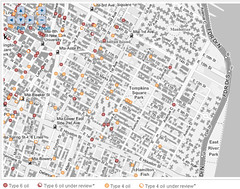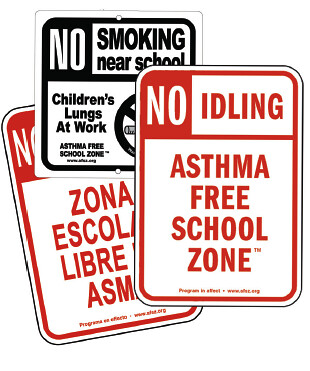 Courtesy of dirtybuildings.orgA screenshot of a Web site that details the buildings in Manhattan that use No. 4 or No. 6 heating oil. Environmentalists say that the buildings produce more air pollution than all of the city’s cars and trucks combined.
Courtesy of dirtybuildings.orgA screenshot of a Web site that details the buildings in Manhattan that use No. 4 or No. 6 heating oil. Environmentalists say that the buildings produce more air pollution than all of the city’s cars and trucks combined.Last month’s anti-smoking legislation may have irritated some Local readers, but environmentalists say that another pollutant continues to fill the air.
An interactive map of New York City’s “dirty buildings” on the Environmental Defense Fund Web site shows over 9,000 red and yellow dots spanning Manhattan, charting real locations of the city’s sludge-burning buildings.
Buildings utilizing No. 4 and 6 heating oil produce more soot pollution than any number of cigarettes could – more than all of New York City’s cars and trucks combined, according to Isabelle Silverman, attorney for the Environmental Defense Fund, a national advocacy group.
Environmentalists say that the buildings’ output of particulate matter can aggravate asthma, increase risk for heart and lung disease, and have other consequences. In two weeks, the Department of Environmental Protection will review a rule to gradually phase out the permits of such structures; so how many of them are in the East Village?
According to the map, the East Village has about 20 buildings burning No. 4 oil and about 20 burning No. 6, which Ms. Silverman said is attributable to the East Village’s relatively smaller apartment complexes and commercial structures. But while other high-density buildings north and west of the village continue to cough up dirty matter, all of Manhattan – which still fails federal health standards – remains susceptible.
“If you look at the East Village on the map and count the dots, it looks like it does not have as many No. 4 and 6 buildings as other areas – like the Upper East Side and Midtown – but of course, air travels,” said Ms. Silverman.
And, advocates say, so does the potential for health problems.
“For a child who has asthma, just one building using dirty oil within a couple of blocks is enough to be a problem,” said Michael Seilback, a spokesman for the American Lung Association in New York.
Some East Villagers are addressing the matter themselves; just across from Tompkins Square Park, the non-profit initiative Asthma Free School Zone has been working since 2001 to help children with respiratory problems, championing acts like the “one-minute idle rule” for cars in New York City school zones.
 Asthma Free School ZoneAnti-pollution material produced by Asthma Free School Zone, a non-profit group.
Asthma Free School ZoneAnti-pollution material produced by Asthma Free School Zone, a non-profit group.Rebecca Kalin, a long-time East Village resident and a founding director of Asthma Free School Zone, explained that although there’s never been a deep community assessment of the East Village, its aging housing stock – with mold, pests, peeling paint – and its proximity to bridges and highways, affects the air quality residents’ breathe and greatly exacerbates health problems.
And while asthma rates in the East Village may read lower than other areas in the city (according to surveys by the Department of Health and Mental Hygiene), Ms. Kalin said it could be attributed to a lack of documentation. “We know that certain pockets of the city have three or four times the national asthma rate, based on hospitalizations; but the East Village is hard to document because it has no hospital. Cultural and social factors come into play — it simply doesn’t make sense that the Lower East Side has lower rates despite 9/11, aging housing, and numerous bridges.”
Still, Ms. Kalin and Mr. Seilback agree that the city’s air quality has generally improved in recent years, largely due to Mayor Michael R. Bloomberg and the City Council’s support of public health initiatives and environmental research like the New York City Community Air Survey. Though New York still ranks in the bottom 20 among the nation’s cities for air quality, it has improved from being in the bottom five. Residents can track the city’s annual progress online.
On March 28, the New York City Department of Environmental Protection will most likely enact a rule of regulation on No. 4 and 6 oil-burning buildings, requiring No. 6 burners to switch to at least No. 4 between 2012 and 2015. Though many East Village buildings will not be affected, it’s likely East Village residents will be — cleaner air is one currency circulated by all in Manhattan.
Join the conversation: Do you live in a building burning No. 4 or 6 oil? Enter your address and find out at dirtybuildings.org.



